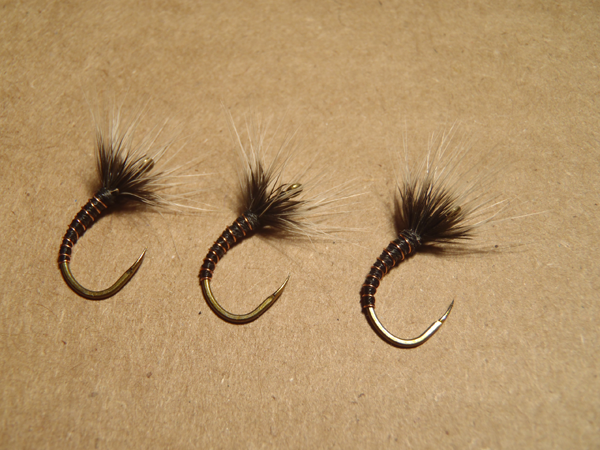These flies might not win any beauty contests above water, but I’m sure they’ll be sexy enough down below. With some classic color combinations, nice contrast, and a bit of weight and movement, I can’t see how these “plain Jane” sakasa kebari wouldn’t catch fish. Here’s the recipe…
Hook: TMC 2499 SPBL # 10
Thread: Black Uni 6/0
Hackle: Whiting Brahma Hen Cape Creme Badger
Rib: Small copper Uni wire









Nice flies. To me this is a big part of the simplicity of Tenkara. The very simple flies you have tied will in most cases fish just as well as the same fly with twice as many steps. When you add action to a fly as you do in true Tenkara having a fly tied right is more important that what it looks like. The more I tie and fish true Tenkara the more I like it.
Nice. Tj
Is this a larger hook than you ordinarily use for a Sas/Keb? Any rule of thumb (other than trial an error on a any given day) for size selection of a Sas/Keb?
Hi Paul, yes. I normally tie on a #12. These are a #10. I wanted to tie a little larger to get the fish’s attention. Plus, the larger hook sinks a little better.
Jason, do you buy hackle feathers online? Care to share the source? You seem to have quite a variety.
Hi Alex,
I sometimes buy online but usually get them from my local shop. I used to work at a fly shop and got a huge discount so that’s why I have so many different materials. The hackle for these flies I bought at Colorado Skies Outfitters (my local shop in Parker, CO). I try to buy locally but if I can’t I like Feathercraft. They pretty much have everything. But I always check eBay first. 🙂
Jason, I noticed that these were tied in black. On my last trip 90% of the entomology of the stream was tan or light tan color, with about 10% black. Are you matching the entomology here?
Hi Chris, no, I’m not. This is an attractor pattern that is meant to get the fish’s attention–not accurately represent any aquatic insects. I do have some sakasa kebari that are closer in color to most insects but last year, my top producing pattern was a black bodied fly with silver ribbing and partridge hackle (which looks nothing like any insect I know). In tenkara, most anglers don’t “match the hatch”. They focus on using movement and position of the fly that trigger the opportunistic predatory response.
So in a perpetual catch and release area (what we have in our area)what would you prefer to fish with, Attractor or match? This time of year the fishing pressure is from experienced anglers (western)since it is winter and the “weekenders” are mostly non-existent. I understand the movement and position more each time. Learning curve here… Then on top of that is fishing Tenkara in Texas and Oklahoma. I think there are 3 of us. People wonder what the heck your doing. I remind myself each time just to concentrate on my environment.
Chris,
On high pressure water, matching the hatch is probably a “safe bet”; however, showing them something different can also be more effective. So, while the fish have probably seen dozens (and have been caught on RS2 nymphs), they probably haven’t seen reverse hackle sakasa kebari with more movement in the tenkara presentation. So, you might actually be better off coaxing them with something outside of the norm. It’s hard to say but worth a try. Give it a shot and let us know what worked and what didn’t.
Jason, that was sort of my plan, but needed another opinion. Thanks!
Jason, do you have any trouble with the wire slipping on the tapered thread bodies? I’ve been suffering some fly failures with this, esp. with rainbows, which always put the fly to a greater test than the brownies.
C
Hi Craig,
It happens sometimes. But mostly it just make the wraps look uneven. The fy is still fishable. You could try coating your flies with clear nail polish or Hard as Nails to prevent the wire from slipping.
Jason thank you for the info on this site. On the sakasa kebari do you ever feel the need for a tungsten bead or weight to get the fly down in the water column?
Great looking cap.
Thanks
Dale
HiDale
You can but I don’t since traditional Tenkara flies don’t use weight